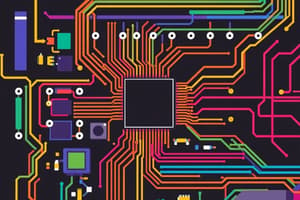Podcast
Questions and Answers
What does Free Software allow users to do?
What does Free Software allow users to do?
- Use without modification
- Access only with a payment
- Distribute only with restrictions
- Change, improve, and distribute freely (correct)
Which component is primarily responsible for processing data in a computer?
Which component is primarily responsible for processing data in a computer?
- Input unit
- Storage unit
- Output unit
- CPU (correct)
What is the role of the Control Unit within the CPU?
What is the role of the Control Unit within the CPU?
- Control and supervise processing activities (correct)
- Perform calculations and comparisons
- Store data and instructions
- Convert input into digital form
What type of memory is RAM?
What type of memory is RAM?
Which of the following is NOT a functional component of a computer?
Which of the following is NOT a functional component of a computer?
ROM is primarily used for what purpose in a computer?
ROM is primarily used for what purpose in a computer?
What does the term 'computer organization' describe?
What does the term 'computer organization' describe?
Which component in the CPU specifically handles arithmetic and logic operations?
Which component in the CPU specifically handles arithmetic and logic operations?
What is the main function of an operating system?
What is the main function of an operating system?
Which unit is responsible for obtaining input from the user?
Which unit is responsible for obtaining input from the user?
Study Notes
Computer System Components
- Physical structure consists of hardware components, while logical structure defined as Computer Organization.
- Computer Organization describes how components are interconnected and influence each other’s functionalities.
- Basic functioning principle: Input → Process → Output.
CPU and Computer Organization
- CPU is a key component composed of:
- ALU (Arithmetic Logic Unit): Executes arithmetic and logical operations.
- Control Unit: Directs the operations of the processor.
- Registers: Small storage locations that temporarily hold data, instructions, and addresses.
System Bus and Units
- Components of basic computer organization include:
- Input Unit: Captures and converts user input to digital form.
- Output Unit: Delivers processed data to the user.
- Storage Unit: Retains data and programs, can be volatile (RAM) or non-volatile (ROM).
- System Bus facilitates communication among the CPU, memory, and input/output units.
Compiler Functionality
- A compiler translates high-level programming code into machine code, enhancing execution speed by eliminating intermediate conversions.
Utility Software
- Utility software supports and enhances computer performance through functions like:
- Data backup
- Virus protection and eradication
- File management and optimization
- Common utilities include:
- Antivirus Software: Protects against malicious attacks.
- Disk Defragmenter: Optimizes disk performance by reducing fragmentation.
- Backup Utility: Duplicates data to recover from losses.
Device Drivers
- Device drivers are essential programs that enable communication between the operating system and hardware devices.
- Each hardware component has a specific driver that allows the operating system to recognize and utilize it effectively.
Custom and Proprietary Software
- Customized software is tailored to meet specific business needs and may not be suitable for other users without modifications.
- Proprietary Software is restricted in use and distribution, while Free Software allows for modification and redistribution.
- Free Libre Open Source Software (FLOSS) combines the principles of both free software and open source, allowing users the freedom to use, modify, and distribute it.
Software Categories
- Open Source Software (OSS): Source code is publicly available for modification without restrictions.
- Free Software: Users can use, change, and distribute without cost.
- Examples of FLOSS include Linux OS, MySQL, and OpenOffice.
Memory Types
- ROM (Read-Only Memory): Stores permanent instructions, not writable.
- RAM (Random Access Memory): Temporarily holds data for processing; it is writable and volatile.
Role of Operating Systems
- Operating systems manage hardware resources, offer user interfaces, and facilitate software applications to function correctly, ensuring overall computer operability.
Studying That Suits You
Use AI to generate personalized quizzes and flashcards to suit your learning preferences.
Related Documents
Description
This quiz focuses on the components and the logical structure of computer systems, specifically addressing computer organization. Participants will explore how different components are connected and function together to create an effective computer system.




